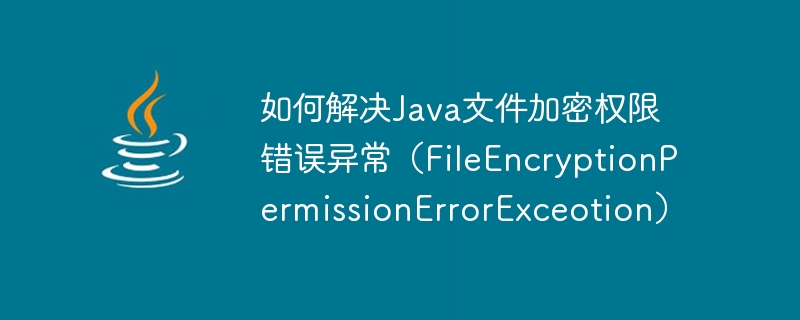
如何解决Java文件加密权限错误异常(FileEncryptionPermissionErrorExceotion)
在开发Java应用程序时,有时候我们需要对文件进行加密以保护数据的安全性。然而,在进行文件加密时,可能会遇到一个名为FileEncryptionPermissionErrorExceotion的权限错误异常。这个异常提示我们没有足够的权限来进行文件加密操作。本文将为大家介绍如何解决这个异常,并提供代码示例来说明解决方法。
出现FileEncryptionPermissionErrorExceotion异常的原因是当前的Java应用程序没有足够的权限来进行文件加密操作。在Java中,文件加密操作涉及到对文件的读写权限控制,而这需要在安全策略中进行设置。
解决这个异常的方法是通过修改Java安全策略文件来提供足够的权限。下面是具体的解决步骤:
立即学习“Java免费学习笔记(深入)”;
步骤1:找到Java安全策略文件
Java安全策略文件是一个名为java.policy的文件,位于Java安装目录下的jrelibsecurity文件夹中。
步骤2:备份安全策略文件
在进行修改前,请务必备份java.policy文件,以防止意外的文件损坏。
步骤3:编辑安全策略文件
使用文本编辑器打开java.policy文件,并在文件的末尾添加以下内容:
grant {
permission java.io.FilePermission ">", "read, write";
};
这段代码的意思是授予Java应用程序对所有文件的读写权限。
步骤4:保存并关闭安全策略文件
保存并关闭java.policy文件。
步骤5:重启Java应用程序
重启Java应用程序,异常应该得到了解决,现在应该有足够的权限进行文件加密操作了。
下面是一个简单的Java文件加密示例,以帮助理解上述解决方法:
import java.io.FileInputStream;
import java.io.FileOutputStream;
import java.io.IOException;
public class FileEncryptionExample {
public static void main(String[] args) {
String inputFilePath = "path/to/input/file.txt"; // 输入文件路径
String outputFilePath = "path/to/output/encrypted_file.txt"; // 输出文件路径
try {
FileInputStream inputFile = new FileInputStream(inputFilePath);
FileOutputStream outputFile = new FileOutputStream(outputFilePath);
int data;
while ((data = inputFile.read()) != -1) {
// 在这里进行文件加密操作
// ...
outputFile.write(data);
}
inputFile.close();
outputFile.close();
System.out.println("文件加密成功!");
} catch (IOException e) {
e.printStackTrace();
}
}
}以上的示例代码假设已经解决了FileEncryptionPermissionErrorExceotion异常,并在适当的位置进行了文件加密操作。
通过修改Java安全策略文件,我们可以为Java应用程序提供足够的权限来进行文件加密操作,从而解决FileEncryptionPermissionErrorExceotion异常。在撰写本文时,请根据自己的具体需求进行权限设置,确保安全策略的合理性。希望本文能够帮助到大家解决这个常见的Java文件加密权限问题。
以上就是如何解决Java文件加密权限错误异常(FileEncryptionPermissionErrorExceotion)的详细内容,更多请关注php中文网其它相关文章!

java怎么学习?java怎么入门?java在哪学?java怎么学才快?不用担心,这里为大家提供了java速学教程(入门到精通),有需要的小伙伴保存下载就能学习啦!

Copyright 2014-2025 //m.sbmmt.com/ All Rights Reserved | php.cn | 湘ICP备2023035733号